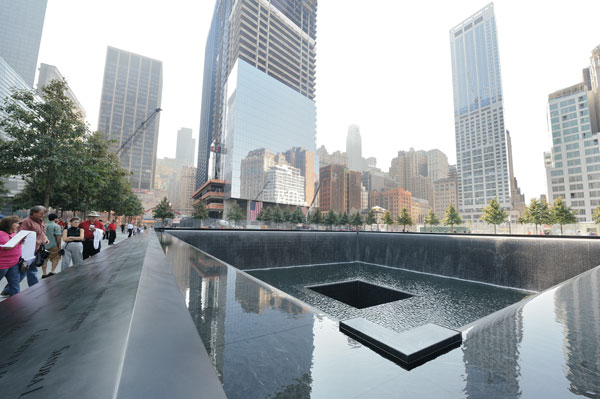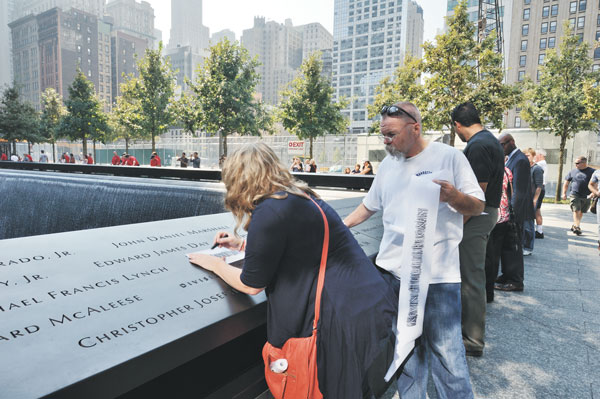
BY TERESE LOEB KREUZER | Reservations can be made online. A visitor pass can be printed at home specifying a date and a time. “Please do not arrive more than 30 minutes prior to your reservation,” the pass says.
But the cynical visitor to the National September 11 Memorial at the World Trade Center site, which opened to the public at 10 a.m. on Sept. 12, might still wonder what awaits at the Albany and Greenwich Street entrance gate. Long lines, perhaps? Chaos? Surly there would be security guards?
Actually none of the above is true. At 10:30 a.m. on Sept. 12, two people stood in line, waiting to be admitted. The guards smiled. They asked several times during the route from the street entrance to the actual entrance to the memorial to see the visitor’s pass but though valid photo ID was also required, no one checked it.
The airport-style screening of body and possessions (no bags are allowed that are more than 8” x 17” x 19”) went quickly and the woman behind the scanning machine was pleasant. A wait of perhaps 10 minutes to actually enter the memorial grounds was accompanied by affable chatter among the strangers in line.
Then, with a few more steps to the other side of a barricade blocking the view, the memorial was there — an expanse of grass and trees and blue sky with two huge pools on the footprints of the destroyed Twin Towers. One World Trade Center rose above them, gleaming in the sun.
The sound of 30-foot-tall waterfalls flowing down the sides of the pools overpowered the sounds of the city and even the noise of construction as work on the National September 11 Museum and 1 and 4 World Trade Center continued.
In the weeks prior to the opening, construction crews worked 24 hours a day to prepare, complicated by intrusions from Tropical Storm Irene. By September 12, when the gates opened to the public, no one who hadn’t seen the plaza in the previous weeks could have guessed what it took to make it look as though it had been there for years.
It would be possible to see the whole memorial in 20 minutes. It wouldn’t take longer than that to walk briskly around the two pools. But most people didn’t walk briskly. They lingered, reading the names that have been incised into metal on the edges of the pools, looking at the tributes left behind by family and friends of the nearly 3,000 victims: flowers, notes, a photo of a little boy and his dad, American flags held erect by the spaces inside the letters.
The letters have been designed so that people can place paper on top of them and take rubbings with soft crayons as they might on a headstone in a cemetery. Many people did just that. Others took photographs, trying to capture something tangible to take home.
One of the names is “Jennifer L. Howley and her unborn child.” A woman snapped a picture. “Did you know her?” the two women asked.
Turns out she was the niece of one of the women and the cousin of the other. They were from Lincoln, Nebraska. Howley worked as a manager for Aon in the South Tower. She was 34 years old, five months pregnant.
“We didn’t find anything afterward except her security badge,” said the older woman, Deb. “We don’t know what happened. There are things that we can live with and things that we can’t. Maybe she was waiting for the elevator when the plane struck the floor she was on. We can live with that — that she died instantly.”
The women said they had made a rubbing of Jennifer’s name to take back to her grandmother in Nebraska.
Former Vice President Dick Cheney passed by with his entourage.
“He’s from Lincoln, Nebraska,” Deb said. “We don’t talk about that much.”
Deb and her daughter said they had last come to New York five years ago, and felt they had to come for the 10th anniversary.
“We like the waterfalls,” Deb said. “It’s peaceful here.”
Though the National September 11 Museum won’t open until September 2012, the exterior has been fitted with electronic boxes that people can use to search for names and their locations on the walls. Many families have provided photos and biographical information about the victims. The names are arranged on the ledges according to how they died: a section for each of the towers, for first responders, for firefighters, for policemen, for people in United Flight 175 and so on. The electronic boxes have maps of the site, showing where to look.
The plaza around the pools has been planted with swamp white oak trees that grow quickly and are known for their longevity. Acorns had fallen from some of the trees onto the plush grass between granite paths.

A metal scaffold and sturdy bands supported one tree, larger than the rest. A callery pear, it is called the “survivor tree.” It was the only tree from the first World Trade Center to survive the attack. Charred but alive, it was taken to a nursery in the Bronx where it was carefully tended. Then it was struck by lightning, but it survived that, too. It is now 35 feet tall. People have placed flowers in the branches of the tree and left bouquets around it.
People are coming to see the memorial from all over the world. Led by a woman with a shaved head wearing a saffron robe, a group approached the entrance.
“Who is she?” a passerby asked.
One of the group replied in halting English, “She is our master — a Buddhist nun. We are from Taiwan. We are going to pray for the souls of the dead — that they find peace.”
“Thank you,” was the passerby’s reply.

















